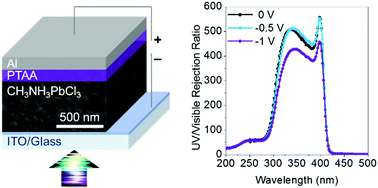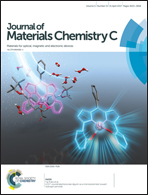Solution-processed visible-blind UV-A photodetectors based on CH3NH3PbCl3 perovskite thin films†
Abstract
In this contribution, methylammonium lead trichloride (CH3NH3PbCl3) perovskite thin films were fabricated via a two-step spin coating and solvent-vapor-assisted thermal annealing method at low temperature. The films exhibited a cubic crystalline structure and pinhole-free morphologies. The possible charge traps were investigated via the analysis of photoluminescence (PL) spectra of perovskite films prepared with different lead chloride (PbCl2) precursor concentrations while maintaining the same concentration of methylammonium chloride (CH3NH3Cl). Prototypical ultraviolet (UV) photodetectors with the structure of ITO/CH3NH3PbCl3/poly(triaryl amine) (PTAA)/Al were fabricated and showed a low dark current density of 1.60 × 10−5 mA cm−2 under a reverse bias of −1 V, a strong photoresponse in the 300–400 nm region, and a high UV-visible rejection ratio of up to 500 under a bias of 0 or −0.5 V. All the results demonstrated that low-temperature solution-processed CH3NH3PbCl3 perovskite thin films offer great potential for making flexible, lightweight visible-blind UV-A photodetectors.



 Please wait while we load your content...
Please wait while we load your content...